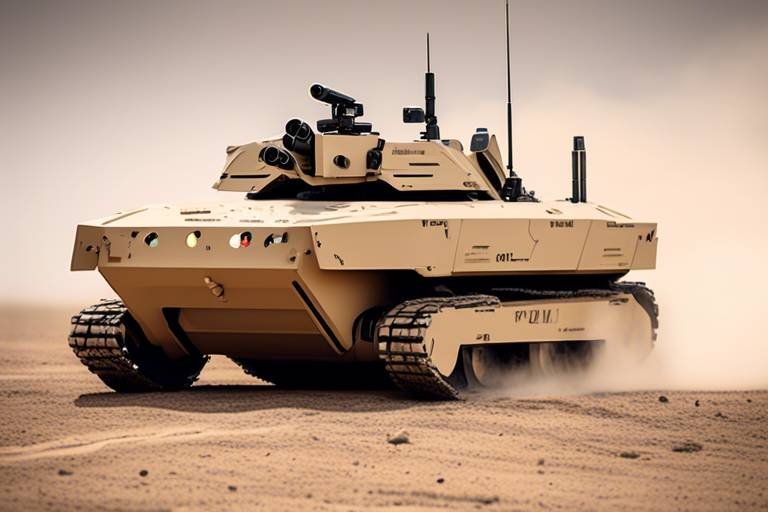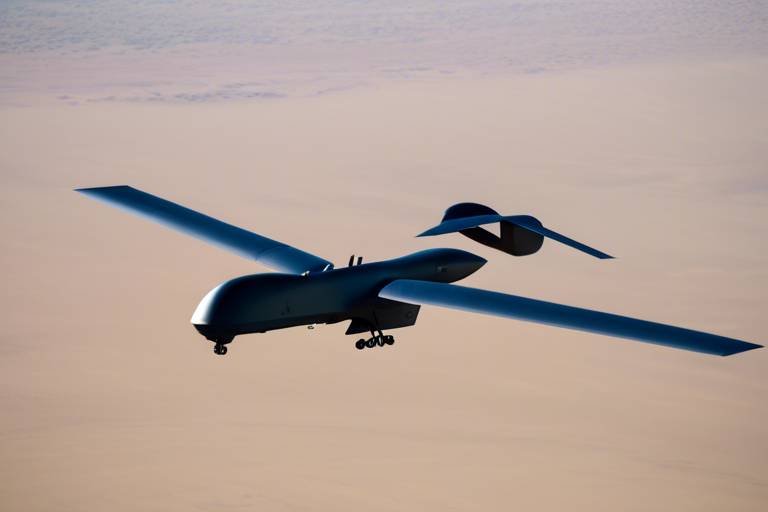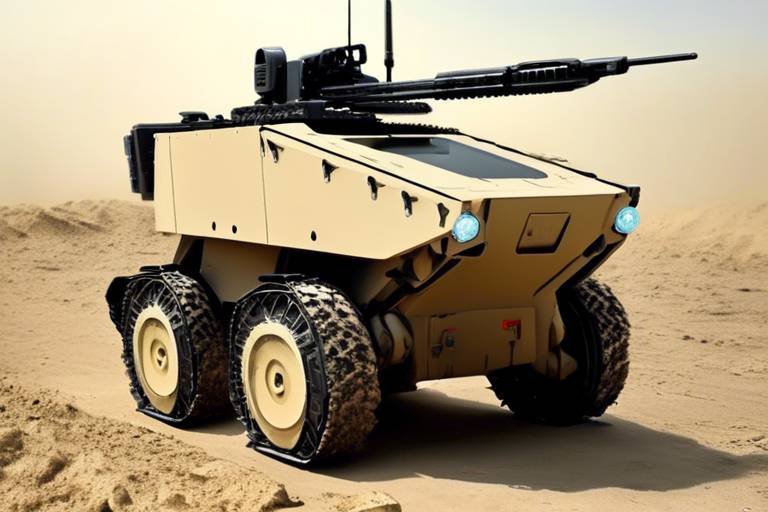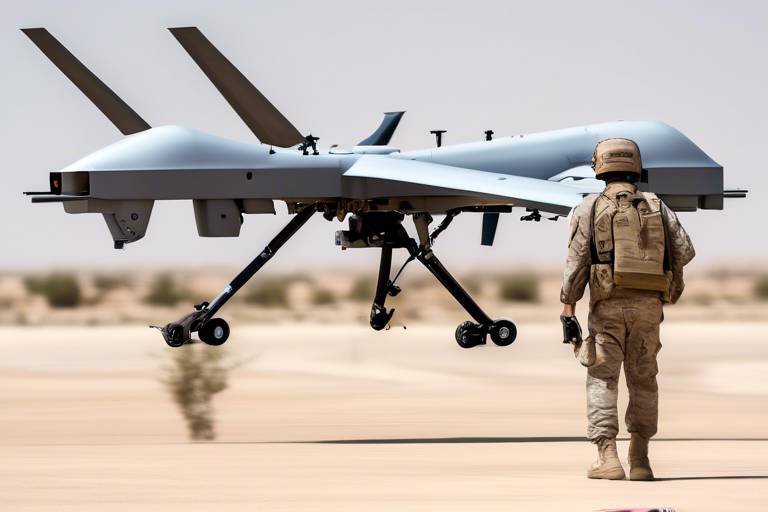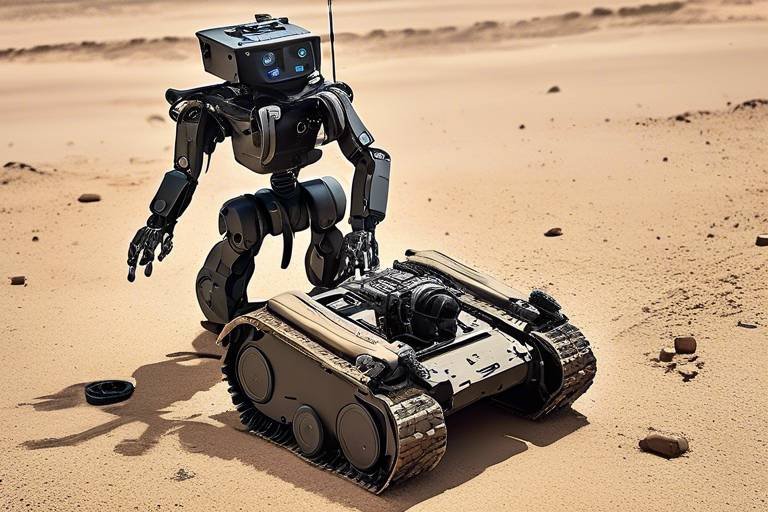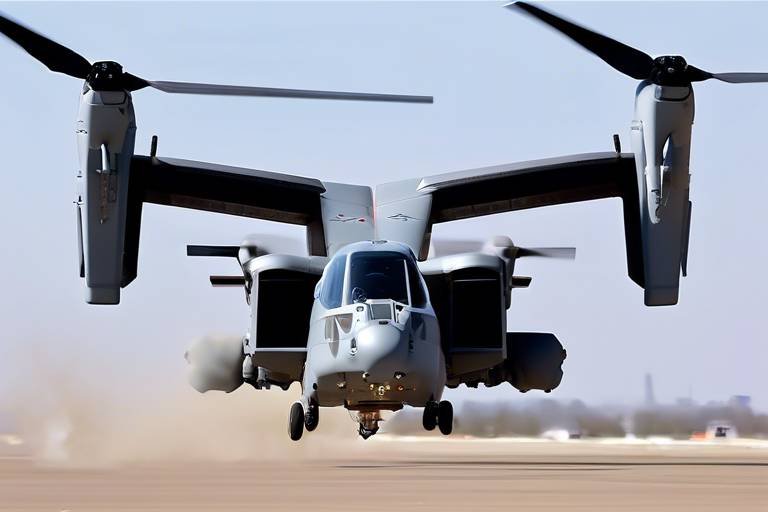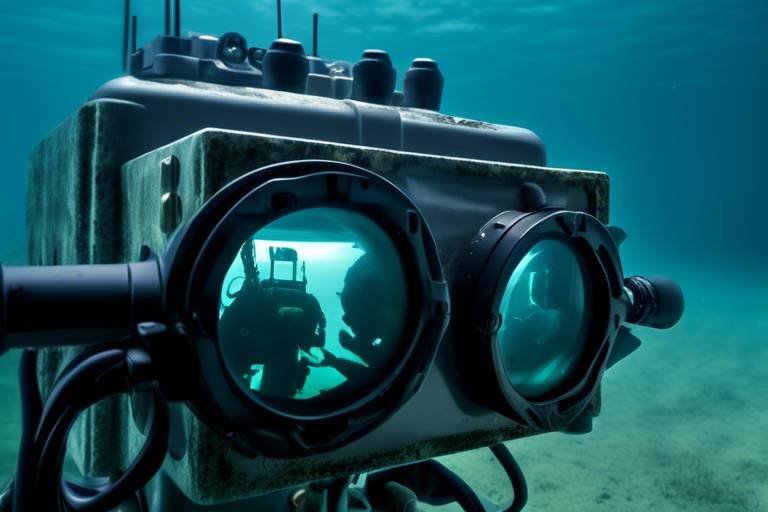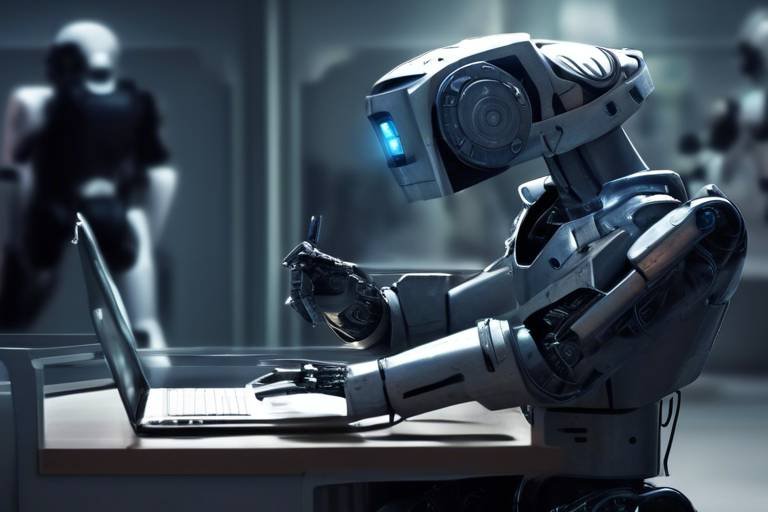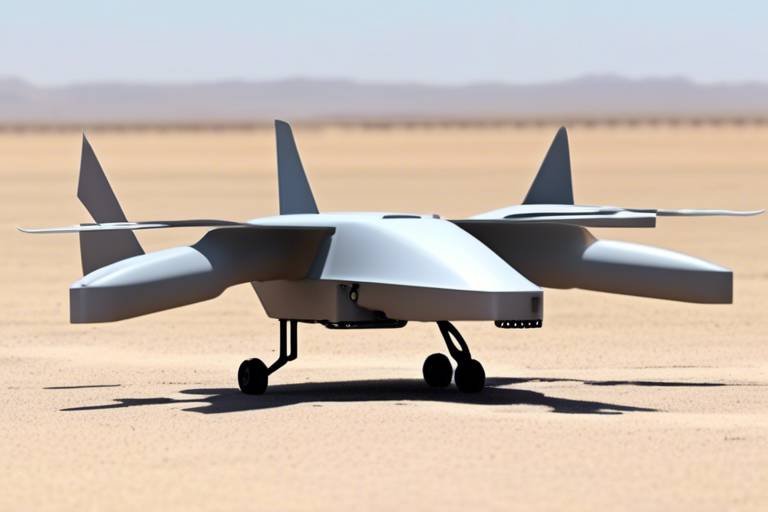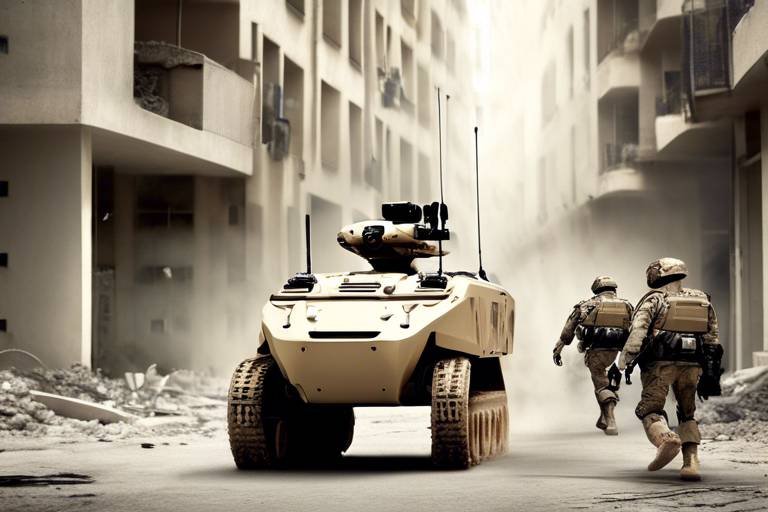The Role of the U.S. Army's Robotic Ground Combat Vehicle
The landscape of modern warfare is constantly evolving, and at the forefront of this transformation are Robotic Ground Combat Vehicles (RGCVs). These technological marvels are not just a glimpse into the future; they are actively reshaping how the U.S. Army approaches combat, logistics, and reconnaissance. Imagine a battlefield where human soldiers can rely on machines to handle the most dangerous tasks, allowing them to focus on strategy and decision-making. This is the reality that RGCVs are creating, and it’s nothing short of revolutionary.
At their core, RGCVs symbolize a shift towards greater automation in military operations. They are designed to operate in environments that are often too perilous for human troops, thereby minimizing risks and enhancing overall mission effectiveness. From carrying supplies to engaging enemy forces, these vehicles are equipped to tackle a variety of roles, which not only increases operational efficiency but also saves lives. The integration of RGCVs into the U.S. Army’s arsenal signifies a commitment to leveraging cutting-edge technology to gain a strategic edge on the battlefield.
Furthermore, the operational capabilities of RGCVs extend beyond mere combat roles. They are equipped with advanced sensors and autonomous navigation systems that allow them to gather intelligence and navigate challenging terrains without human intervention. This capability is crucial in modern warfare, where information and speed can determine the outcome of a conflict. By utilizing RGCVs, the U.S. Army can enhance its situational awareness and responsiveness in dynamic combat scenarios.
As we delve deeper into the various aspects of RGCVs, we’ll explore their technological innovations, operational benefits, and the future implications they hold for military strategy. The integration of these robotic systems is not just a trend; it is a fundamental shift in how the U.S. Army will operate in the years to come, redefining the very nature of warfare.
- What are Robotic Ground Combat Vehicles?
RGCVs are unmanned vehicles designed to assist in military operations, including combat, reconnaissance, and logistics. - How do RGCVs improve soldier safety?
By taking on dangerous tasks, RGCVs reduce the risk to human soldiers, allowing them to focus on strategic roles. - What technologies are used in RGCVs?
RGCVs utilize advanced robotics, artificial intelligence, GPS, mapping technologies, and various sensors for navigation and situational awareness. - What are the future implications of RGCVs for military strategy?
The integration of RGCVs will likely influence how the U.S. Army conducts warfare, potentially changing engagement tactics and resource allocation.

Overview of Robotic Ground Combat Vehicles
Robotic Ground Combat Vehicles (RGCVs) are revolutionizing the battlefield, introducing a new era of military operations that blends cutting-edge technology with strategic prowess. These vehicles are not just machines; they are a testament to the relentless pursuit of innovation within the U.S. Army. Imagine a scenario where soldiers can send in a robotic unit to scout dangerous territories or engage in combat, all while remaining safely behind the lines. This capability significantly enhances operational efficiency and minimizes risks to human life.
At their core, RGCVs are designed to perform a variety of tasks that were traditionally the domain of human soldiers. Their primary functions include:
- Reconnaissance: RGCVs can gather intelligence in real-time, providing valuable data that informs strategic decisions.
- Logistics Support: These vehicles can transport supplies and equipment to troops in remote or hazardous locations, ensuring that essential resources are delivered without risking human lives.
- Combat Engagement: Some RGCVs are equipped with weaponry, allowing them to engage enemy forces directly, further reducing the exposure of soldiers to combat situations.
The significance of RGCVs extends beyond their immediate capabilities. They symbolize a shift in military strategy, where technology plays a pivotal role in enhancing combat effectiveness. As the U.S. Army integrates these advanced vehicles into its operations, the dynamics of warfare are changing. The ability to deploy robotic units not only increases the tactical options available to commanders but also shifts the focus of military training and strategy toward a more tech-centric approach.
Moreover, the development of RGCVs is closely linked to advancements in artificial intelligence, machine learning, and robotics. These technologies enable RGCVs to operate autonomously, making real-time decisions based on environmental data and mission parameters. For instance, imagine a robot navigating through a dense forest, using its sensors to detect obstacles and adjust its path without human intervention. This level of autonomy allows RGCVs to operate in complex environments where human soldiers might struggle, thereby extending the reach and effectiveness of military operations.
In summary, the role of RGCVs in the U.S. Army is not merely about replacing human soldiers; it's about enhancing operational capabilities and redefining how military missions are conducted. As we look to the future, it is clear that RGCVs will continue to play an integral role in shaping military strategies, providing a blend of safety, efficiency, and effectiveness on the battlefield.
- What are Robotic Ground Combat Vehicles?
RGCVs are unmanned vehicles designed to perform various military tasks, including reconnaissance, logistics, and combat support. - How do RGCVs enhance soldier safety?
By taking on dangerous tasks, RGCVs reduce the risk to human soldiers, allowing them to focus on strategic operations from a safe distance. - What technologies are used in RGCVs?
RGCVs utilize advanced robotics, artificial intelligence, and sensor technologies to navigate and operate autonomously in diverse environments. - Will RGCVs replace human soldiers?
While RGCVs enhance military capabilities, they are designed to support, not replace, human soldiers in various operations.

Technological Innovations in RGCVs
In the rapidly evolving landscape of military technology, robotic ground combat vehicles (RGCVs) stand out as a beacon of innovation. These vehicles are not just machines; they are embodiments of cutting-edge advancements in robotics, artificial intelligence, and sensor technology. Imagine a vehicle that can analyze its surroundings, make autonomous decisions, and navigate through treacherous terrains—all without a human operator at the wheel. That’s the power of RGCVs, and it’s revolutionizing the battlefield.
One of the most remarkable aspects of RGCVs is their autonomous navigation systems. These systems utilize sophisticated algorithms and real-time data to allow the vehicles to traverse rugged terrains with ease. Whether it’s rocky hills, dense forests, or urban environments, RGCVs can adapt and maneuver effectively. This capability minimizes the need for human intervention, thereby reducing the risk to soldiers who would otherwise be exposed to danger.
At the heart of autonomous navigation lies GPS and mapping technologies. These tools provide RGCVs with precise location data, enabling accurate navigation and mission planning. Picture this: a soldier on the ground can send an RGCV into a hostile area, confident that it will find its way back safely, all while gathering vital intelligence. The integration of high-definition maps and real-time GPS data allows for seamless operations, even in unfamiliar territories, making them invaluable assets in combat scenarios.
But it doesn't stop there. The sensor integration in RGCVs is another game-changer. Equipped with an array of cameras, radar, and other advanced sensors, these vehicles are capable of detecting threats and gathering intelligence in real-time. This situational awareness is crucial for military effectiveness. For instance, during reconnaissance missions, RGCVs can scan vast areas, identify enemy positions, and relay that information back to command centers without putting human lives at risk. The data collected can be analyzed to inform strategic decisions, enhancing overall mission success.
Moreover, the integration of artificial intelligence into these systems allows RGCVs to learn from their environment. As they operate, they can adapt to new challenges and improve their performance over time. This self-learning capability is akin to having a soldier who gets better with every mission, making RGCVs not just tools, but evolving partners on the battlefield.
In summary, the technological innovations in RGCVs are not merely enhancements; they represent a fundamental shift in how military operations are conducted. With autonomous navigation, advanced GPS and mapping technologies, and sophisticated sensor integration, RGCVs are paving the way for a new era of warfare. They not only increase operational efficiency but also enhance the safety of our soldiers, allowing them to focus on what truly matters: strategy and execution.
- What are robotic ground combat vehicles (RGCVs)?
RGCVs are unmanned vehicles designed for military operations, capable of performing tasks such as reconnaissance, logistics, and combat support. - How do RGCVs navigate without human operators?
RGCVs utilize autonomous navigation systems that rely on advanced algorithms, GPS, and real-time data to make decisions and navigate their environment. - What role do sensors play in RGCVs?
Sensors provide situational awareness, enabling RGCVs to detect threats and gather intelligence, which is crucial for mission success. - How do RGCVs improve soldier safety?
By taking on dangerous tasks, RGCVs reduce the risk to human soldiers, allowing them to focus on strategic decision-making.

Autonomous Navigation Systems
The advent of has revolutionized the way robotic ground combat vehicles (RGCVs) operate on the battlefield. Imagine a vehicle that can traverse perilous terrains, dodge obstacles, and make split-second decisions—all without a human pilot. That's the magic of autonomous navigation! These systems are designed to enhance the operational efficiency of RGCVs, allowing them to perform complex maneuvers in environments that would be challenging for human operators.
At the heart of these systems lies a combination of advanced algorithms and real-time data. By processing vast amounts of information from various sources, RGCVs can create a dynamic map of their surroundings. This capability allows them to navigate through rugged landscapes, urban environments, and even hostile territories. Think of it as a highly skilled driver who never gets tired, distracted, or lost—always focused on the mission at hand.
One of the key components of autonomous navigation is the use of GPS and mapping technologies. These technologies provide precise location data, enabling RGCVs to plot their routes accurately. For instance, when an RGCV is deployed in an unfamiliar territory, it can utilize GPS signals combined with detailed mapping information to navigate effectively. This not only enhances the vehicle's ability to reach its destination but also improves mission planning, ensuring that troops can operate in the most efficient and safe manner possible.
Moreover, the integration of sensor technology plays a critical role in empowering RGCVs with situational awareness. Equipped with cameras, LIDAR, and radar systems, these vehicles can detect threats and gather intelligence in real-time. This means that while navigating through dangerous zones, an RGCV can identify enemy positions, avoid ambushes, and relay crucial information back to command centers. The combination of autonomous navigation and advanced sensor integration creates a formidable tool for military operations, allowing for enhanced safety and effectiveness on the battlefield.
In summary, autonomous navigation systems are a game-changer for RGCVs, transforming them into highly capable assets that can operate independently in diverse environments. As technology continues to advance, we can expect these systems to become even more sophisticated, further enhancing the operational capabilities of the U.S. Army's robotic ground combat vehicles.
- What are autonomous navigation systems?
These are advanced technologies that allow vehicles to navigate and operate without human intervention, using algorithms and real-time data.
- How do RGCVs utilize GPS?
RGCVs use GPS for precise location tracking, which aids in accurate navigation and mission planning in unfamiliar or hostile environments.
- What role do sensors play in autonomous navigation?
Sensors provide situational awareness, allowing RGCVs to detect threats and gather intelligence, enhancing their operational effectiveness.

GPS and Mapping Technologies
This article explores the significance of robotic ground combat vehicles in the U.S. Army, their technological advancements, operational benefits, and future implications for military strategy and effectiveness.
Robotic ground combat vehicles (RGCVs) represent a significant technological advancement in military operations, enhancing capabilities for reconnaissance, logistics, and combat support while minimizing risks to human soldiers on the battlefield.
Recent innovations in robotics, artificial intelligence, and sensor technology have propelled the development of RGCVs, enabling them to perform complex tasks and operate autonomously in diverse and challenging environments.
Autonomous navigation systems allow RGCVs to traverse rugged terrains without human intervention, utilizing advanced algorithms and real-time data to make decisions and avoid obstacles efficiently.
GPS and mapping technologies are the backbone of modern RGCV operations, providing the essential data that enables these vehicles to navigate complex terrains with precision. Imagine trying to find your way in a dense forest or an urban battlefield; without accurate maps and location data, it would be like searching for a needle in a haystack. The integration of GPS technology allows RGCVs to pinpoint their location within a few meters, ensuring that they can carry out missions effectively, even in unfamiliar or hostile environments.
The sophisticated mapping technologies employed by RGCVs include:
- Real-time Terrain Mapping: RGCVs utilize advanced algorithms to create dynamic maps of their surroundings, allowing for quick adjustments to their routes based on changing conditions.
- Geospatial Intelligence: By analyzing satellite imagery and other geographical data, RGCVs can identify strategic points of interest and potential hazards, making them invaluable for reconnaissance missions.
- Integration with Command Systems: The GPS data collected by RGCVs can be shared with command centers, providing a comprehensive picture of the battlefield and aiding in strategic decision-making.
This combination of GPS and mapping technologies not only enhances the operational effectiveness of RGCVs but also contributes to the overall safety of military personnel. By enabling vehicles to navigate autonomously, the risk to human soldiers is significantly reduced, allowing them to focus on higher-level tactical decisions rather than getting bogged down in navigation challenges.
Sensor integration plays a critical role in situational awareness for RGCVs, equipping them with cameras, radar, and other sensors to detect threats and gather intelligence in real-time.
RGCVs are designed to support various combat roles, including direct engagement with enemy forces, reconnaissance missions, and logistical support, thus enhancing the overall combat effectiveness of military units.
The deployment of RGCVs offers numerous operational benefits, including increased force protection, reduced logistical burdens, and enhanced mission capabilities, ultimately contributing to more effective military strategies.
By taking on dangerous tasks, RGCVs significantly reduce the risk to human soldiers, allowing military personnel to focus on strategic decision-making and other critical functions on the battlefield.
RGCVs streamline logistical operations by transporting supplies and equipment to remote or hazardous locations, ensuring that troops receive necessary resources without exposing them to potential threats.
As technology continues to evolve, the integration of RGCVs into military operations will shape future strategies, influencing how the U.S. Army conducts warfare and interacts with adversaries in various conflict scenarios.
- What are Robotic Ground Combat Vehicles (RGCVs)?
- RGCVs are unmanned ground vehicles designed to perform various military tasks, including reconnaissance, logistics, and direct combat support.
- How do RGCVs improve soldier safety?
- By taking on high-risk tasks, RGCVs reduce the exposure of human soldiers to danger, allowing them to focus on strategy and decision-making.
- What technologies are used in RGCVs?
- RGCVs utilize advanced technologies such as GPS, mapping systems, artificial intelligence, and sensor integration for navigation and situational awareness.
- What is the future of RGCVs in military operations?
- As technology advances, RGCVs are expected to play an increasingly significant role in military strategy, enhancing operational effectiveness and altering how wars are fought.

Sensor Integration for Situational Awareness
The battlefield is a chaotic environment, filled with uncertainties and rapid changes. In such a setting, situational awareness becomes paramount. This is where sensor integration in Robotic Ground Combat Vehicles (RGCVs) shines. By equipping RGCVs with an array of advanced sensors, the U.S. Army has taken a giant leap towards enhancing operational effectiveness and safety. Imagine a soldier in a combat zone, relying on real-time data gathered from drones and ground vehicles to make split-second decisions. That's the power of integrated sensors!
RGCVs are outfitted with a variety of sensors that work in tandem to provide comprehensive situational awareness. These include high-resolution cameras, infrared sensors, and radar systems, all designed to detect and identify threats from a distance. For instance, while a soldier might be limited to their line of sight, an RGCV can scan a wide area, providing a panoramic view of the battlefield. This capability not only aids in threat detection but also assists in intelligence gathering, allowing military leaders to make informed decisions based on accurate data.
Furthermore, the integration of these sensors enables the RGCVs to operate in challenging environments, such as urban settings or dense forests, where visibility is often compromised. With the help of advanced algorithms, RGCVs can process sensor data in real-time, identifying potential hazards like enemy combatants or improvised explosive devices (IEDs). This swift processing capability is crucial, as it allows for immediate responses, potentially saving lives on the ground.
To illustrate the importance of sensor integration, consider the following table that outlines the key types of sensors used in RGCVs and their respective functionalities:
| Sensor Type | Functionality |
|---|---|
| High-Resolution Cameras | Provide visual data for reconnaissance and target identification. |
| Infrared Sensors | Detect heat signatures, useful for spotting hidden enemies or equipment. |
| Radar Systems | Measure distance and detect objects through various weather conditions. |
| Acoustic Sensors | Capture sound signatures to identify the location of gunfire or vehicle movement. |
In summary, the integration of sensors into RGCVs is not just a technological enhancement; it's a game-changer for military operations. By providing real-time data and improving situational awareness, these vehicles allow commanders to make better strategic decisions, ultimately leading to more successful missions. As we look to the future, the role of sensor integration in RGCVs will undoubtedly continue to evolve, further transforming the landscape of modern warfare.
- What are Robotic Ground Combat Vehicles (RGCVs)? RGCVs are unmanned vehicles designed to perform various military tasks, including reconnaissance, logistics, and direct combat support.
- How do sensors improve the effectiveness of RGCVs? Sensors provide real-time data on the battlefield, enhancing situational awareness and enabling quick decision-making.
- What types of sensors are commonly used in RGCVs? Common sensors include high-resolution cameras, infrared sensors, radar systems, and acoustic sensors.
- Can RGCVs operate autonomously? Yes, many RGCVs are designed to operate autonomously, using advanced algorithms to navigate and make decisions without human intervention.

Combat Roles of RGCVs
Robotic Ground Combat Vehicles (RGCVs) are not just a futuristic concept; they are a reality reshaping the battlefield today. Their combat roles are diverse and multifaceted, contributing significantly to the effectiveness of military operations. Imagine a vehicle that can scout enemy positions, deliver supplies, and even engage in direct combat—this is the essence of RGCVs. They are designed to support various combat roles, which can be categorized into three primary functions: direct engagement, reconnaissance, and logistical support.
In terms of direct engagement, RGCVs can be equipped with advanced weaponry, enabling them to engage enemy forces while minimizing the risk to human soldiers. This capability is especially crucial in high-stakes scenarios where human lives are on the line. By utilizing RGCVs for direct combat, military units can maintain a tactical advantage without exposing personnel to unnecessary danger. Think of it as having an extra set of hands that can take on the most dangerous tasks, allowing soldiers to focus on strategy and coordination.
When it comes to reconnaissance missions, RGCVs excel at gathering intelligence in hostile environments. These vehicles can traverse difficult terrains and gather critical information about enemy movements and positions. Equipped with high-resolution cameras and advanced sensors, they can relay real-time data back to command centers, providing a clearer picture of the battlefield. This capability is akin to having a bird's-eye view, enabling military leaders to make informed decisions based on accurate and timely information.
Furthermore, RGCVs play a vital role in logistical support. They can transport essential supplies, equipment, and even medical aid to troops stationed in remote or dangerous locations. This reduces the logistical burden on human soldiers and ensures that vital resources are delivered promptly and safely. Imagine trying to deliver a pizza in a war zone; it’s not just about getting it there, but doing so without attracting unwanted attention. RGCVs navigate these challenges, ensuring that troops are well-equipped and ready for action.
To sum it up, the combat roles of RGCVs are not just about replacing human soldiers; they are about enhancing the overall combat effectiveness of military units. They act as force multipliers, allowing for more efficient operations and reducing the risks associated with traditional combat roles. As the technology behind these vehicles continues to advance, their roles on the battlefield will undoubtedly expand, leading to even greater innovations in military strategy.
- What are the primary functions of RGCVs? RGCVs are designed for direct engagement, reconnaissance, and logistical support.
- How do RGCVs enhance soldier safety? By taking on dangerous tasks, RGCVs reduce the risk to human soldiers, allowing them to focus on critical functions.
- Can RGCVs operate autonomously? Yes, RGCVs are equipped with autonomous navigation systems that allow them to operate with minimal human intervention.
- What technological advancements have contributed to the development of RGCVs? Innovations in robotics, artificial intelligence, and sensor technology have propelled the development of RGCVs.

Operational Benefits of RGCVs
The deployment of Robotic Ground Combat Vehicles (RGCVs) in military operations brings a plethora of operational benefits that significantly enhance the effectiveness of the U.S. Army. One of the most notable advantages is the increased force protection provided by these advanced machines. By taking on the most dangerous tasks, RGCVs help to shield human soldiers from harm, allowing them to focus on strategic decision-making and critical battlefield functions. Imagine a scenario where a convoy is ambushed; instead of sending soldiers into the line of fire, RGCVs can be dispatched to assess the situation, gather intelligence, and even engage the enemy, keeping personnel safe.
Moreover, RGCVs play an essential role in logistical operations. They are designed to transport supplies and equipment to remote or hazardous locations, ensuring that troops receive necessary resources without exposing them to potential threats. This capability is particularly crucial in modern warfare, where traditional supply lines can be vulnerable to enemy action. With RGCVs handling logistics, the military can maintain a steady flow of supplies, which is vital for sustained operations. The efficiency of RGCVs can be illustrated in the table below:
| Operational Benefit | Description |
|---|---|
| Increased Force Protection | Minimizes human risk by taking on dangerous tasks. |
| Enhanced Logistics | Streamlines supply transport to remote locations. |
| Real-time Intelligence Gathering | Equipped with sensors for immediate threat detection. |
| Operational Efficiency | Reduces time and resource expenditure in missions. |
Furthermore, RGCVs are equipped with advanced sensor technologies that allow them to gather real-time intelligence. This capability enhances situational awareness, enabling military units to make informed decisions based on accurate data. The integration of various sensors—such as cameras, radar, and LIDAR—allows RGCVs to detect threats and monitor the battlefield effectively. By relaying this information back to command units, they help create a comprehensive picture of the operational environment.
In addition to these benefits, RGCVs also contribute to improved mission capabilities. They can operate in environments that are too hazardous for human soldiers, such as areas with chemical or biological threats, or in extreme weather conditions. This versatility means that the U.S. Army can maintain operational readiness and effectiveness, regardless of the challenges posed by the battlefield. The use of RGCVs not only enhances the immediate tactical situation but also influences long-term strategic planning, allowing military leaders to adapt to emerging threats and changing warfare dynamics.
Overall, the operational benefits of RGCVs are clear: they enhance force protection, streamline logistics, improve situational awareness, and expand mission capabilities. As technology continues to advance, the role of these robotic vehicles in military operations is set to grow, making them an indispensable asset for the U.S. Army.
- What are Robotic Ground Combat Vehicles (RGCVs)?
RGCVs are advanced military robots designed to perform various tasks such as reconnaissance, logistics, and combat support, reducing the risk to human soldiers. - How do RGCVs enhance force protection?
By taking on dangerous missions, RGCVs minimize the exposure of human soldiers to threats on the battlefield. - What technologies are used in RGCVs?
RGCVs utilize advanced sensors, autonomous navigation systems, and artificial intelligence to operate effectively in diverse environments. - Can RGCVs operate in hazardous conditions?
Yes, RGCVs are designed to function in environments that may be too dangerous for human soldiers, such as areas with chemical threats or extreme weather.

Force Protection and Risk Reduction
This article explores the significance of robotic ground combat vehicles in the U.S. Army, their technological advancements, operational benefits, and future implications for military strategy and effectiveness.
Robotic ground combat vehicles (RGCVs) represent a significant technological advancement in military operations, enhancing capabilities for reconnaissance, logistics, and combat support while minimizing risks to human soldiers on the battlefield.
Recent innovations in robotics, artificial intelligence, and sensor technology have propelled the development of RGCVs, enabling them to perform complex tasks and operate autonomously in diverse and challenging environments.
Autonomous navigation systems allow RGCVs to traverse rugged terrains without human intervention, utilizing advanced algorithms and real-time data to make decisions and avoid obstacles efficiently.
GPS and mapping technologies enhance the operational effectiveness of RGCVs by providing precise location data, enabling accurate navigation and mission planning in unfamiliar or hostile territories.
Sensor integration plays a critical role in situational awareness for RGCVs, equipping them with cameras, radar, and other sensors to detect threats and gather intelligence in real-time.
RGCVs are designed to support various combat roles, including direct engagement with enemy forces, reconnaissance missions, and logistical support, thus enhancing the overall combat effectiveness of military units.
The deployment of RGCVs offers numerous operational benefits, including increased force protection, reduced logistical burdens, and enhanced mission capabilities, ultimately contributing to more effective military strategies.
In the realm of modern warfare, the safety of military personnel is paramount. Robotic Ground Combat Vehicles (RGCVs) play a pivotal role in enhancing force protection by taking on the most dangerous tasks on the battlefield. Imagine sending a machine into a hostile environment where the risks are high and the stakes even higher. By utilizing RGCVs, the U.S. Army can significantly reduce the exposure of human soldiers to life-threatening situations.
These advanced vehicles are equipped with a variety of features designed to minimize risks. For instance, RGCVs can perform reconnaissance missions in areas that are heavily fortified or known to be dangerous. This capability allows commanders to gather crucial intelligence without putting troops in harm's way. The ability to scout ahead and assess threats can be the difference between life and death in combat scenarios.
Additionally, RGCVs can be deployed in explosive ordnance disposal (EOD) operations. Instead of sending a human into potentially deadly situations to disarm explosives, these robotic units can handle such tasks, significantly decreasing the risk of injury or loss of life. This not only protects soldiers but also ensures that critical missions can be accomplished more effectively.
Furthermore, the psychological impact of using RGCVs cannot be understated. Knowing that there are machines handling the most perilous tasks can boost the morale of troops, allowing them to focus on their primary responsibilities without the constant fear of imminent danger. This shift in focus enhances overall operational efficiency and decision-making on the battlefield.
In summary, the integration of RGCVs into military operations is a game-changer for force protection and risk reduction. By leveraging technology to take on the most hazardous tasks, the U.S. Army can ensure that its soldiers are not only safer but also more effective in their missions. The future of warfare is evolving, and with it, the strategies that will shape the battlefield.
As technology continues to evolve, the integration of RGCVs into military operations will shape future strategies, influencing how the U.S. Army conducts warfare and interacts with adversaries in various conflict scenarios.
- What are Robotic Ground Combat Vehicles (RGCVs)? RGCVs are advanced robotic systems designed to perform various military tasks, including reconnaissance, logistics, and combat support.
- How do RGCVs enhance force protection? By taking on dangerous tasks, RGCVs reduce the risk to human soldiers, allowing them to focus on strategic decision-making.
- What technologies are used in RGCVs? RGCVs utilize advanced robotics, artificial intelligence, GPS, and various sensor technologies for navigation and situational awareness.
- What are the future implications of RGCVs in military strategy? The integration of RGCVs will likely influence how the U.S. Army conducts warfare, focusing on minimizing human risk while maximizing operational effectiveness.

Enhanced Logistics and Support
In the ever-evolving landscape of modern warfare, the logistical capabilities of military forces are paramount to mission success. Robotic Ground Combat Vehicles (RGCVs) are revolutionizing this aspect by acting as the backbone of logistical support. Imagine a scenario where troops are stationed in remote locations, cut off from supply lines. Traditional methods of resupply can be slow and dangerous, often exposing soldiers to enemy fire. This is where RGCVs step in, acting as lifelines that deliver essential supplies with minimal risk.
These vehicles can transport a variety of materials, including ammunition, food, water, and medical supplies, directly to the front lines. Equipped with advanced navigation systems, they can navigate treacherous terrains that would otherwise be inaccessible to conventional transport vehicles. This capability not only ensures that troops receive what they need when they need it, but it also allows for a more flexible and responsive logistical strategy.
Furthermore, RGCVs can operate in hazardous environments, where the threat of ambush or improvised explosive devices (IEDs) looms large. By utilizing these robotic vehicles for resupply missions, human soldiers can remain at a safer distance, focusing on strategic operations rather than worrying about the risks associated with logistics. This separation of roles enhances overall mission effectiveness and allows for a more tactical approach to warfare.
One of the most impressive features of RGCVs is their ability to communicate with other military assets in real-time. This interconnectivity allows for seamless coordination between ground troops and support units, ensuring that logistical needs are met promptly. For instance, if a unit is running low on ammunition during a firefight, an RGCV can be dispatched immediately, equipped with the necessary supplies and guided by live data from the battlefield.
Moreover, the operational benefits extend to cost efficiency. By automating supply runs, the U.S. Army can reduce the number of personnel required for logistical operations. This not only saves money on manpower but also minimizes the risks associated with having more soldiers in potentially dangerous areas. In essence, RGCVs provide a dual advantage: enhancing the safety of troops while simultaneously optimizing operational costs.
In summary, the integration of RGCVs into logistical operations represents a significant leap forward in military strategy. They not only enhance the speed and efficiency of supply chains but also ensure that soldiers can focus on their primary mission—engaging the enemy and achieving victory. As technology continues to advance, the potential for RGCVs in logistics will only grow, paving the way for a new era in military operations.
- What are Robotic Ground Combat Vehicles (RGCVs)?
RGCVs are unmanned ground vehicles designed to support military operations by performing tasks such as reconnaissance, logistics, and direct engagement with enemy forces.
- How do RGCVs enhance logistics in the military?
RGCVs streamline logistical operations by transporting supplies directly to troops in the field, minimizing risks and ensuring timely delivery of essential resources.
- What technologies do RGCVs utilize?
RGCVs use advanced navigation systems, GPS, mapping technologies, and various sensors to navigate and operate effectively in diverse environments.
- Can RGCVs operate autonomously?
Yes, many RGCVs are equipped with autonomous navigation capabilities, allowing them to traverse difficult terrains and make real-time decisions without human intervention.

Future Implications for Military Strategy
As we gaze into the horizon of military operations, the integration of Robotic Ground Combat Vehicles (RGCVs) is poised to revolutionize how the U.S. Army approaches warfare. Imagine a battlefield where human soldiers can focus on strategic planning while their robotic counterparts handle the most perilous tasks. This shift is not just a possibility; it is fast becoming a reality. With advancements in technology, the role of RGCVs will expand, influencing military tactics and reshaping the very fabric of combat operations.
One of the most significant implications of RGCVs is the potential for asymmetric warfare. In an era where adversaries may not be evenly matched in terms of resources, the ability to deploy autonomous vehicles can level the playing field. For instance, smaller nations or non-state actors could leverage RGCVs to enhance their combat capabilities without needing a large standing army. This could lead to a new wave of conflicts where technology, rather than sheer numbers, dictates success on the battlefield.
Moreover, the adaptability of RGCVs in various operational environments means that military strategies will need to evolve accordingly. Commanders will have to consider the unique strengths and weaknesses of these robotic systems when planning missions. This could lead to a more dynamic approach to warfare, where strategies are adjusted in real-time based on the capabilities of RGCVs and the nature of the battlefield. The ability to gather intelligence and respond swiftly with robotic units could redefine the concept of speed and surprise in military engagements.
However, with great power comes great responsibility. The ethical implications of using RGCVs in combat cannot be overlooked. As these machines become more autonomous, questions arise about accountability and the rules of engagement. For instance, if an RGCV makes a decision that results in civilian casualties, who is held responsible? These dilemmas will challenge military leaders and policymakers to establish clear guidelines and regulations governing the use of robotic systems in warfare.
Furthermore, the integration of RGCVs will likely lead to a shift in military training and doctrine. Soldiers will need to be trained not only to operate alongside these robotic systems but also to understand their limitations and capabilities. This could result in a new breed of military personnel who are adept at both traditional combat and advanced technological operations. As a result, the military might implement new training programs that emphasize collaboration between humans and machines, fostering a more cohesive operational environment.
In conclusion, the future implications of RGCVs for military strategy are vast and multifaceted. From enhancing operational effectiveness to presenting ethical challenges, these technologies will force the U.S. Army to rethink its approach to warfare. As we embrace this new era of combat, it is crucial to balance innovation with responsibility, ensuring that the integration of robotic systems enhances not only military effectiveness but also aligns with ethical standards. The battlefield of tomorrow will be a complex interplay of human ingenuity and robotic precision, where the stakes are higher than ever.
- What are Robotic Ground Combat Vehicles (RGCVs)?
RGCVs are advanced military vehicles designed to perform various tasks on the battlefield, including reconnaissance, logistics, and combat support, with minimal human intervention. - How do RGCVs enhance military strategy?
RGCVs allow for increased force protection, reduce logistical burdens, and enable quicker, more effective responses to threats, ultimately shaping future military strategies. - What ethical concerns are associated with RGCVs?
The use of RGCVs raises questions about accountability, rules of engagement, and the potential for unintended civilian casualties, necessitating clear guidelines for their deployment. - Will soldiers need new training to work with RGCVs?
Yes, military training will evolve to include the operation and collaboration with robotic systems, preparing soldiers for a more technologically integrated battlefield.
Frequently Asked Questions
-
What are Robotic Ground Combat Vehicles (RGCVs)?
Robotic Ground Combat Vehicles (RGCVs) are advanced military machines designed to operate autonomously or semi-autonomously on the battlefield. They enhance military operations by performing various roles, including reconnaissance, logistics, and direct combat support, while minimizing risks to human soldiers.
-
How do RGCVs navigate in challenging environments?
RGCVs utilize sophisticated autonomous navigation systems that incorporate advanced algorithms and real-time data. This technology allows them to traverse rugged terrains, avoid obstacles, and make decisions without human intervention, ensuring they can operate effectively in diverse conditions.
-
What technological innovations are integrated into RGCVs?
Recent advancements in robotics, artificial intelligence, and sensor technology have significantly improved RGCVs. These innovations include GPS and mapping technologies for precise navigation, as well as sensor integration for enhanced situational awareness, enabling them to detect threats and gather intelligence in real time.
-
What combat roles do RGCVs fulfill?
RGCVs are versatile and can perform multiple combat roles such as engaging enemy forces, conducting reconnaissance missions, and providing logistical support. This flexibility enhances the overall combat effectiveness of military units by allowing them to adapt to various mission requirements.
-
How do RGCVs improve force protection?
By taking on the most dangerous tasks, RGCVs significantly reduce the risk to human soldiers. This allows military personnel to focus on strategic decision-making and other critical functions, ultimately enhancing overall safety and effectiveness on the battlefield.
-
What are the logistical benefits of using RGCVs?
RGCVs streamline logistical operations by efficiently transporting supplies and equipment to remote or hazardous locations. This capability ensures that troops receive the necessary resources without exposing them to potential threats, thereby improving operational efficiency.
-
What are the future implications of RGCVs for military strategy?
As technology continues to advance, the integration of RGCVs into military operations is expected to shape future strategies significantly. They will influence how the U.S. Army conducts warfare and interacts with adversaries, adapting to various conflict scenarios with enhanced capabilities.

